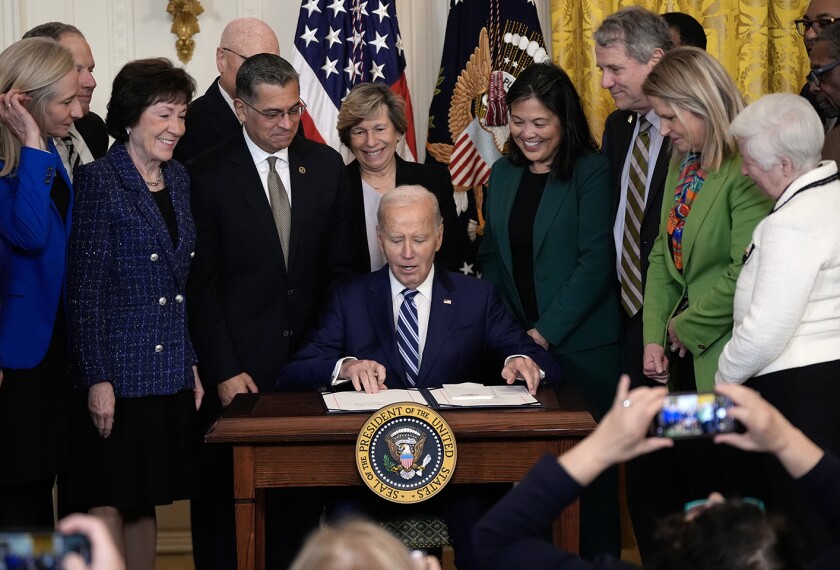Corrected: An earlier version of this story gave an incorrect title for Stephanie C. Hill. She is the vice president of programs and Baltimore site operations with Lockheed Martin Maritime Systems and Sensors division.
Defense contractors Northrop Grumman Corp. and Lockheed Martin Corp. are joining forces here in an innovative partnership to develop high-tech simulations to boost STEM—or science, technology, engineering, and mathematics—education in the Baltimore County schools.
And experts see the partnership as something districts around the country may follow as they too seek better ways to improve STEM education.
“If students are to be ready to compete in the global economy, this kind of program is exactly the kind of experience they need,” said Lydia M. Logan, the executive director of the Institute for a Competitive Workforce, an arm of the U.S Chamber of Commerce in Washington. She said other high-tech companies in the defense industry, such as Boeing, Siemens, Intel, and IBM, are also supporting STEM education in schools.
Competitors Collaborating
The Baltimore County partnership includes the local operations of two major military contractors—Northrop Grumman and Lockheed Martin—as well as researchers at Johns Hopkins University, an institution that also does work for the military.
Baltimore County Superintendent Joe A. Hairston brought together the partners, which had independent initiatives in the 105,000-student district’s schools, to get a jump on technology that his students and teachers otherwise might not see for decades.
Joe A. Hairston, Baltimore County Superintendent
“Technology goes to the military first,” Mr. Hairston told education publishers at a meeting in Arlington, Va., last month that was addressing the need for better digital curricula. “They hang on to it for 20 years, then give it to the commercial sector when they are done with it.” Only then do the technologies filter into products for education, he said.
“I want to cut out the middle man,” he said, at the Oct. 2 technology summit of the school division of the American Association of Publishers.
Plans are for the two defense contractors to develop virtual-reality simulations or other software tools that bring to the classroom real-world activities involving STEM subjects and that connect company employees to science and engineering students and teachers in the Baltimore County schools.
Groundwork activities include teacher “externships,” visits to four participating schools, and joint planning sessions. Educators are now deciding on curriculum areas that could be addressed using the technology. Researchers at the Johns Hopkins University’s Center for Technology in Education have nearly completed a prototype digital environment for teaching science and math by having students conduct a search-and-rescue mission to find a child lost on Mount St. Helens.
It is unusual for Los Angeles-based Northrop Grumman and Bethesda, Md.-based Lockheed Martin to be working jointly, because the companies are fierce competitors for defense contracts and for the technically qualified workers near their facilities.
But the defense contractors have a common need to maintain the quality and quantity of those talent pools.
“Having technology and engineering students not just interested, but excited about majoring in engineering and science and technology is incredibly important to our industry and incredibly important to the nation,” said Stephanie C. Hill, vice president of programs and Baltimore site operations with Lockheed Martin Maritime Systems and Sensors division, which is based in Middle River, Md., and produces the Littoral Combat Ship, which the U.S. Navy calls its first “next-generation” combat vessel.
“Lockheed Martin has been committed for some time to increasing the number of students who have sustained interest in technical careers,” she said. “We think you have to start early.”
Classroom Connections
Northrop Grumman, which develops advanced radar systems and rocket launchers at its Electronic Systems division in Baltimore, has for a decade sent volunteer employees to local schools for STEM-related activities, but has noticed limits to that approach.
“We’re a productive company, and one of the problems [with school involvement] is it takes engineers away from the workplace,” said Ted E. Imes Sr., the director of community and education outreach for the Northrop Grumman plant in Baltimore.
“This is a proof-of-concept of a way to place engineers and students together and to minimize the amount of time they have to be away from the facility,” Mr. Imes said.
Several teachers from Baltimore County’s Chesapeake High STEM Academy, for instance, spent two weeks last summer on externships at the Lockheed Martin Maritime Systems and Sensors plant.
Thomas Bullerman, an engineering teacher at Chesapeake who did an externship, helped employees design a ballast system for a boat using software to model the performance of the design.
“We could do that in my design class, and send it Lockheed Martin engineers” to create a computer model of the design that could be tested, Mr. Bullerman said. “We would also build a physical model to test.”
He added that Lockheed Martin engineers could use Web and video conferences, as well as shared software tools, to respond to students’ questions without having to visit the schools.
Demeterice Smith, who teaches AP biology and AP environmental science to 10th and 11th graders at Chesapeake, did her externship in the environmental safety and health office at the same plant. She aims to have her students develop safety and health procedures for the school’s science and engineering labs that are modeled after the ones she observed.
One of Northrop Grumman’s major efforts for the partnership, still at a conceptual stage, is to give Baltimore County classrooms involved in STEM activities remote access to some of its scientists, and possibly to develop simulations that students could use with feedback from the scientists, Mr. Imes said.
Realistic Simulations
The virtual Mount St. Helens project that the Johns Hopkins researchers are developing is an example of using virtual environments to create realistic narratives that will interest students in applying their knowledge and skills, according to David Peloff, the program director of the Center for Technology in Education.
The center joined the partnership when the school district offered to provide a school as a pilot site for testing its simulation. To succeed in challenges such as finding the child lost on the mountain, students will have to understand concepts such as latitude and longitude, vector, speed, and altitude—which are presented on a console on the students’ virtual search vehicles—and use them in real-world strategies of search and rescue.
The game, which will be tested at Deep Creek Middle School, is not as polished as commercial games. “Keep in mind that most commercial 3D video games cost millions to produce, and our budget was a small fraction of that,” Mr. Peloff said, noting that it has been developed under a 3-year grant from the U.S. Department of Education to look at how emerging technologies from the military and corporate worlds might be harnessed for classroom uses.
An adviser to the partnership is Joe Biglin, the former chief operating officer and cofounder of Hunt Valley, Md.-based BreakAway Ltd., a maker of so-called serious games, virtual environments being used for training by companies in various industries, including the military and health care.
Mr. Biglin said the projects with the Baltimore district are just opening the book on ways school districts might tap the high-tech resources accessible through military contractors.
Over the past decade, he said, the Department of Defense has poured millions of dollars into developing realistic simulations and games to replace some live training of troops and other personnel.
For instance, a simulation created by Mr. Biglin’s former company helps train doctors and nurses to anticipate issues they will encounter in receiving wounded soldiers and marines returning from war in Iraq. Its medical puzzles, as in real life, cannot be answered by selecting one of four or five simple choices; instead, the game allows an almost infinite number of solutions, Mr. Biglin said.
Solving Problems
Christopher J. Dede, a professor of learning technologies at Harvard University who has pioneered work on immersive 3-D simulations for education, said those kinds of tools, if well-designed, offer benefits that bolster other teaching approaches used in schools.
Simulations reveal to teachers how students transfer their knowledge and skills from textbooks to a “real-world” situation, he said. “Kids can be really good at tests and score high on tests,” he said, “but don’t solve the same problems in real life.”
“Another kind of win,” he added, “is an engagement win, when a kid who is not interested in school but is interested in gaming might find this a way to learn.”
For defense contractors such as the ones in the Baltimore County partnership and other companies, such games could help surmount a major limitation of mentoring programs.
“Mentoring programs where company experts are working with kids, they’re not scalable,” Mr. Dede said. “There are only so many experts and only so much time the experts have.”





